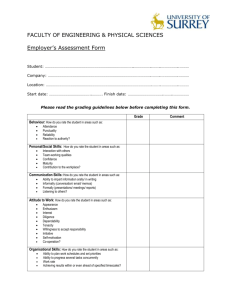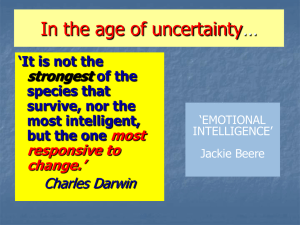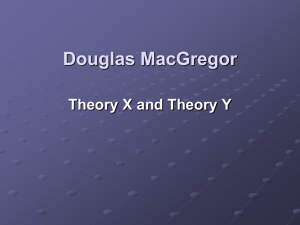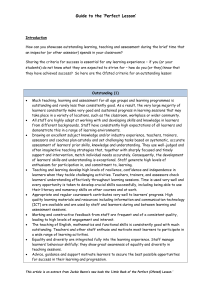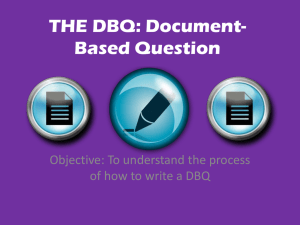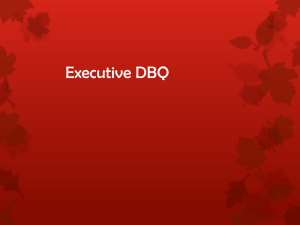The Perfect lesson
advertisement
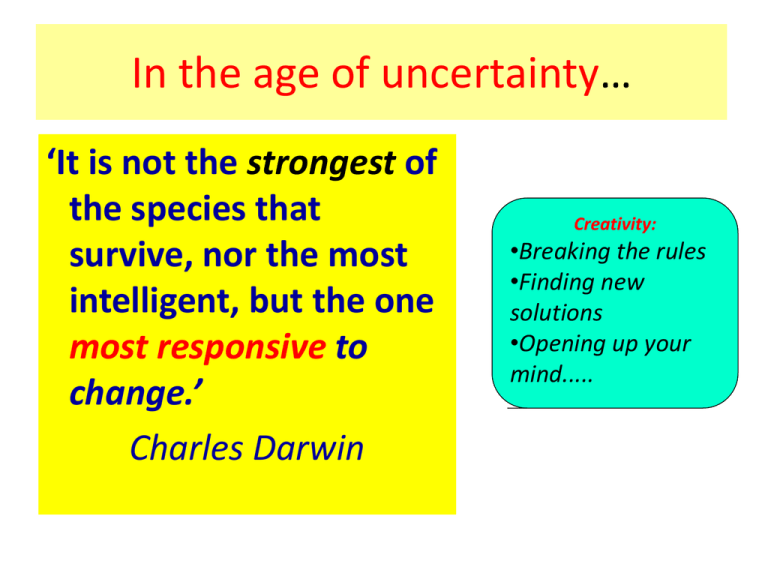
In the age of uncertainty… ‘It is not the strongest of the species that survive, nor the most intelligent, but the one most responsive to change.’ Charles Darwin Creativity: •Breaking the rules •Finding new solutions •Opening up your mind..... What does ‘outstanding’ creativity look like? What if? Is a broken down car parked? Does a cat think? Where does the sky begin? What does sadness taste like? WRONG RIGHT How do you see it? Success and failure are a perception Create a state of curiosity Does how you see it change the outcome? State of the nation survey 1998-2008 Campaign for Learning How do students prefer to learn? 56% prefer practical (35% in 1998) 37% prefer computers 17% from a teacher (29% in 1998) How do students actually experience learning in school? 65% copy from board or book 63% listening to a teacher talking for a long time (these scores had been steadily declining until shooting back up last year) TOP CAUSAL FACTORS FOR PERSISTENT ABSENCE: •DULL LESSONS WITH TOO MUCH TEACHER TALK. •WORK IS TOO EASY WITH NO PACE AND CHALLENGE Thinking NOVELTY RULES Emotional Primitive What is ‘outstanding’? Learning and progress • • • • The quality of learning is exceptional. Students demonstrate excellent concentration and are rarely off task even for extended periods without adult direction They have developed a resilience when tackling challenging activities Their keenness and commitment to succeed in all aspects of school life and ability to grasp opportunities to extend and improve their learning are exceptional. Progress is at least good for different groups of students and exemplary for some students. Teaching and assessment • • Teaching is at least good and often outstanding as students are making exceptional progress. Students are enthused which ensures they learn really well. Excellent subject knowledge is applied to challenge and inspire students. Resources, including new technology make a marked contribution to learning as does the targeted support from other adults Teachers are aware of students’ capabilities and their prior learning and understanding and plan effectively to build on these. Marking and dialogue between teachers and other adults and students are of consistently high quality. It’s all about demonstrating progress Pause for thought / Reflection time “Here is Edward Bear, coming downstairs now, bump, bump, bump on the back of his head behind Christopher Robin. It is, as far as he knows, the only way of coming downstairs. But sometimes he feels there really is another way, if only he could stop bumping for a moment and think of it.” - (A. A. Milne 1882 – 1956) 8 Demonstrating progress How? Objectives/Learning outcomes (differentiated) To know some strategies for encouraging creativity in the classroom that improve progress in learning Fully confident to use strategies and share with others To demonstrate creative thinking Engaged in more innovative thinking that creates new solutions Encouraging creativity 1. 2. 3. 4. 5. 6. 7. The power of quantity Make yourself uncomfortable Mantle of the expert – fake it to make it Stories and metaphors Another way – room, resources, recording New technology – text, blog, twitter Turn on the Association machine Teachers - what’s the difference? Satisfactory? Fount of knowledge ‘filling empty vessels’ Didactic – teacher guides students Teacher questions Outcome focus Intelligence is fixed Teacher talks Outstanding Facilitator Student centred activity Students construct questions/challenges Students co-designers Students judge success, self correcting Creative opportunities Success and failure equal partners for learning Reflection/ metacognition Develops habits/dispositions Language for learning Differentiated outcomes CREATIVE, COLLABORATIVE, CHALLENGING A student-led curriculum ..\Teaching children not subjects\Create your own country task plan doc.doc ..\Teaching children not subjects\Eco Festival task plan.doc ..\Primary learners toolkit\Section 3 'WEDDING PLAN' scheme and materials.doc Do lots of DIRT Dedicated Improvement and Reflection Time CREATIVELY.... Excellence is not an art but a habit - Aristotle Learning to learn – the secret skill • Developing a set of skills and habits that facilitate a self-awareness and resilience in learning. • Being able to transfer skills and learning from one context to another • Understanding how you as an individual learn best and knowing how to use this effectively HOW? Using meta-cognition(thinking about learning) to develop the above as part of the school experience Use PLTs framework •Self manager •Effective participator •Creative thinker •Reflective learner •Independent Enquirer •Team worker Aims of Education rephrased “Education's purpose is to replace an empty mind with an open one.” - Malcom S. Forbes (1919 – 1990) “The mind is not a vessel to be filled, but… a fire to be lighted” - Plutarch (46 – 120) 16 Thanks for listening jackie.beere@virgin.net www.jackiebeere.com • ‘The Teacher’s Toolkit’ Paul Ginnis, Crown House • ‘The Learner’s Toolkit’ Jackie Beere, Crown House • ‘The Little Book of Inspirational Teaching Activities’ David Hodgson, Crown House • ‘The Lazy Teacher’s Handbook’ Jim Smith, Crown House Slide 17 PowerPoint Presentation ISBN 9781845901264 Crownhouse Publishing ISBN 9781845900700
